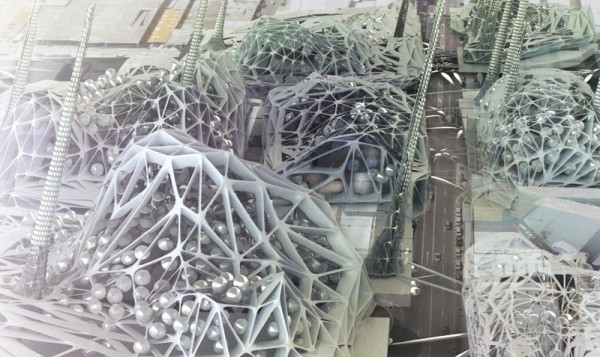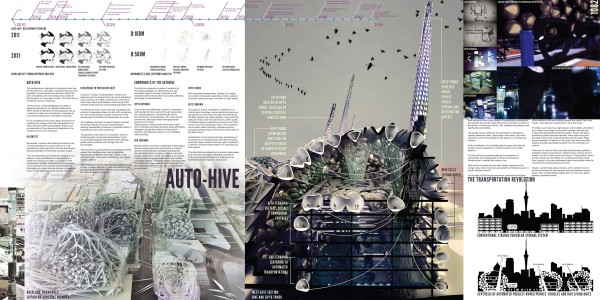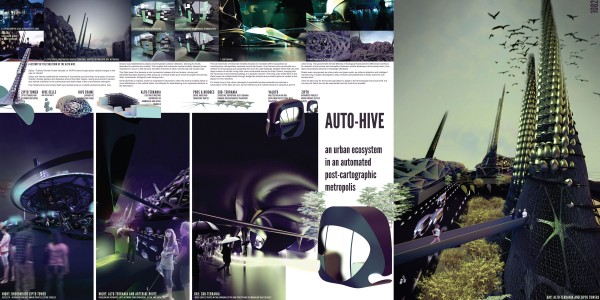Finalist
2011 Skyscraper Competition
HyeYun Oh, Yunwei Xu
New Zealand
It can be said that both architecture and urban design of the contemporary metropolises and suburbs are directly influenced by the reinvention of modes of movement such as lifts, subways, and automobiles.
As a result of such inter-twined development between the automobiles and modern urbanism, the world at large is undergoing what may be described as a ‘bifurcation’; experiencing concurrent population, technological and information shifts.
This point of instability due to energy crisis allows for the formation of a ‘new state of order’. The Auto-Hive Project is conceived as such a response.
Newmarket, is a primer retail district and arterial route of central Auckland, New Zealand which is threatened by rapid population shift and decades of unchecked suburban sprawl.
The concepts of connectedness and movement became a vital question during the design process, where densification is augmented by a system for increasing mobility; an evolution in the transportation network. As a result, Newmarket was re-envisioned as a sub-metropolis in a proposed post-cartographic information era within the design project, where physical location is negated in favor of connectedness in the new city-network.
Speculative prototypes of the vehicles in this new mobility network were designed and named ‘Zipto’ and ‘Valuto’; each taking on roles similar to cars and buses.
The Zipto is conceived as a light-weight, small mobility unit fuelled by a carbon free energy source with a fully automated global positioning system. The Valuto acts in a similar way except that it is intended for long-distance uses.
There are no longer roads to follow, but just optimized pathways guided by intelligent collision proof sensors. Ziptos travel in swarms around nodes or sit idle in Zipto towers until required. These ‘publicly owned private vehicles’ can be utilized on a prepaid prescription basis, their ubiquity in the urban landscape means their mobility rivals the convenience of present-day taxi services.
City infrastructure and society itself is now divided along an invisible vertical boundary. Sub-terrain was established as Ziptos evolved greater collision detection, allowing for levels purely dedicated to vehicles and mobility. This coupled with enhanced vertical mobility allowed human interaction to occur in alto-terrain; elevated channels of retail, commercial and socials hubs.
Society now gathers and disperses around the Zipto Towers, acting as prominent markers and vertical channels for the commercial and retail nodes of the re-envisioned metropolis. They are the vital connection between the two terrains, storing and administering Zipto dispersal while acting as a vertical street upon which all human programmes could diverge from.
The conveniences of enhanced mobility thus induce an increased shift in population as contemporary metropolitans swarm around the towers. Hive frames are conceived as a method of re-purposing and supporting the once dis-used buildings in parasitic manner. Multiple Hives that can hold large number of cell-like ‘living units’ are placed around the Zipto Towers. The living units all link back to the Zipto towers at multiple levels through bridge-like strands, providing optimum access to the Ziptos for Hive residents.

















